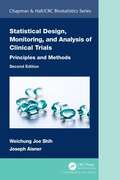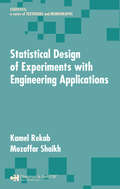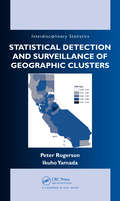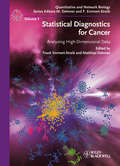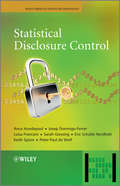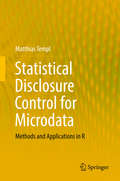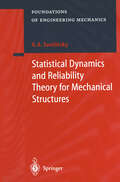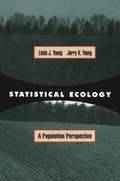- Table View
- List View
Statistical Design for Research (Wiley Series in Survey Methodology #540)
by Leslie KishThe Wiley Classics Library consists of selected books that have become recognized classics in their respective fields. With these new unabridged and inexpensive editions, Wiley hopes to extend the life of these important works by making them available to future generations of mathematicians and scientists. This title addresses those basic aspects of research design which are common to many related fields in the social sciences, health sciences, education, and market research. The work presents a unified approach to a common core of problems of statistical design that exists in all these fields, along with basic similarities in practical solutions. Describing many examples and analogies that are 'portable' from application field to application field, Statistical Design for Research deals with designs that are the primary basis of research studies, but are neglected in most statistical textbooks that tend to concentrate on statistical analysis. This text takes a broader, more general and philosophical view of the statistics for the more fundamental aspects of design than do the standard treatments of experimental design. Extensively illustrated and carefully organized into seven chapters and 44 sections, this book can be readily consulted by research workers or graduate students!
Statistical Design, Monitoring, and Analysis of Clinical Trials: Principles and Methods (Chapman & Hall/CRC Biostatistics Series)
by Weichung Joe Shih Joseph AisnerStatistical Design, Monitoring, and Analysis of Clinical Trials, Second Edition concentrates on the biostatistics component of clinical trials. This new edition is updated throughout and includes five new chapters. Developed from the authors’ courses taught to public health and medical students, residents, and fellows during the past 20 years, the text shows how biostatistics in clinical trials is an integration of many fundamental scientific principles and statistical methods. The book begins with ethical and safety principles, core trial design concepts, the principles and methods of sample size and power calculation, and analysis of covariance and stratified analysis. It then focuses on sequential designs and methods for two-stage Phase II cancer trials to Phase III group sequential trials, covering monitoring safety, futility, and efficacy. The authors also discuss the development of sample size reestimation and adaptive group sequential procedures, phase 2/3 seamless design and trials with predictive biomarkers, exploit multiple testing procedures, and explain the concept of estimand, intercurrent events, and different missing data processes, and describe how to analyze incomplete data by proper multiple imputations. This text reflects the academic research, commercial development, and public health aspects of clinical trials. It gives students and practitioners a multidisciplinary understanding of the concepts and techniques involved in designing, monitoring, and analyzing various types of trials. The book’s balanced set of homework assignments and in-class exercises are appropriate for students and researchers in (bio)statistics, epidemiology, medicine, pharmacy, and public health.
Statistical Design, Monitoring, and Analysis of Clinical Trials: Principles and Methods (Chapman & Hall/CRC Biostatistics Series)
by Weichung Joe Shih Joseph AisnerStatistical Design, Monitoring, and Analysis of Clinical Trials, Second Edition concentrates on the biostatistics component of clinical trials. This new edition is updated throughout and includes five new chapters. Developed from the authors’ courses taught to public health and medical students, residents, and fellows during the past 20 years, the text shows how biostatistics in clinical trials is an integration of many fundamental scientific principles and statistical methods. The book begins with ethical and safety principles, core trial design concepts, the principles and methods of sample size and power calculation, and analysis of covariance and stratified analysis. It then focuses on sequential designs and methods for two-stage Phase II cancer trials to Phase III group sequential trials, covering monitoring safety, futility, and efficacy. The authors also discuss the development of sample size reestimation and adaptive group sequential procedures, phase 2/3 seamless design and trials with predictive biomarkers, exploit multiple testing procedures, and explain the concept of estimand, intercurrent events, and different missing data processes, and describe how to analyze incomplete data by proper multiple imputations. This text reflects the academic research, commercial development, and public health aspects of clinical trials. It gives students and practitioners a multidisciplinary understanding of the concepts and techniques involved in designing, monitoring, and analyzing various types of trials. The book’s balanced set of homework assignments and in-class exercises are appropriate for students and researchers in (bio)statistics, epidemiology, medicine, pharmacy, and public health.
Statistical Design of Experiments with Engineering Applications (Statistics: Textbooks and Monographs)
by Kamel RekabIn today's high-technology world, with flourishing e-business and intense competition at a global level, the search for the competitive advantage has become a crucial task of corporate executives. Quality, formerly considered a secondary expense, is now universally recognized as a necessary tool. Although many statistical methods are available for
Statistical Detection and Surveillance of Geographic Clusters
by Peter Rogerson Ikuho YamadaThe widespread popularity of geographic information systems (GIS) has led to new insights in countless areas of application. It has facilitated not only the collection and storage of geographic data, but also the display of such data. Building on this progress by using an integrated approach, Statistical Detection and Monitoring of Geographic Clust
Statistical Development of Quality in Medicine (Statistics in Practice #62)
by Per Winkel Nien Fan ZhangThe promotion of standards and guidelines to advance quality assurance and control is an integral part of the health care sector. Quantitative methods are needed to monitor, control and improve the quality of medical processes. Statistical Development of Quality in Medicine presents the statistical concepts behind the application of industrial quality control methods. Filled with numerous case studies and worked examples, the text enables the reader to choose the relevant control chart, to critically apply it, improve it if necessary, and monitor its stability. Furthermore, the reader is provided with the necessary background to critically assess the literature on the application of control charts and risk adjustment and to apply the findings. Contains a user-friendly introduction, setting out the necessary statistical concepts used in the field. Uses numerous real-life case studies from the literature and the authors’ own research as the backbone of the text. Provides a supplementary website featuring problems and answers drawn from the book, alongside examples in Statgraphics. The accessible style of Statistical Development of in Clinical Medicine invites a large readership. It is primarily aimed at health care officials, and personnel responsible for developing and controlling the quality of health care services. However, it is also ideal for statisticians working with health care problems, diagnostic and pharmaceutical companies, and graduate students of quality control.
Statistical Diagnostics for Cancer: Analyzing High-Dimensional Data (Quantitative and Network Biology (VCH))
by Frank Emmert-StreibThis ready reference discusses different methods for statistically analyzing and validating data created with high-throughput methods. As opposed to other titles, this book focusses on systems approaches, meaning that no single gene or protein forms the basis of the analysis but rather a more or less complex biological network. From a methodological point of view, the well balanced contributions describe a variety of modern supervised and unsupervised statistical methods applied to various large-scale datasets from genomics and genetics experiments. Furthermore, since the availability of sufficient computer power in recent years has shifted attention from parametric to nonparametric methods, the methods presented here make use of such computer-intensive approaches as Bootstrap, Markov Chain Monte Carlo or general resampling methods. Finally, due to the large amount of information available in public databases, a chapter on Bayesian methods is included, which also provides a systematic means to integrate this information. A welcome guide for mathematicians and the medical and basic research communities.
Statistical Diagnostics for Cancer: Analyzing High-Dimensional Data (Quantitative and Network Biology (VCH))
by Frank Emmert-StreibThis ready reference discusses different methods for statistically analyzing and validating data created with high-throughput methods. As opposed to other titles, this book focusses on systems approaches, meaning that no single gene or protein forms the basis of the analysis but rather a more or less complex biological network. From a methodological point of view, the well balanced contributions describe a variety of modern supervised and unsupervised statistical methods applied to various large-scale datasets from genomics and genetics experiments. Furthermore, since the availability of sufficient computer power in recent years has shifted attention from parametric to nonparametric methods, the methods presented here make use of such computer-intensive approaches as Bootstrap, Markov Chain Monte Carlo or general resampling methods. Finally, due to the large amount of information available in public databases, a chapter on Bayesian methods is included, which also provides a systematic means to integrate this information. A welcome guide for mathematicians and the medical and basic research communities.
Statistical Diagrams - Opting for a Pie Chart or a Bar Chart (tactile)
by RnibThis three-page diagram shows two examples of a pie chart, followed by a bar chart. The pie chart consists of simple lines, with labels and a key. The bar chart uses different textures to show separate data, with a key and labelled axis. The final image will need to be rotated into a landscape position to be viewed in the correct orientation.
Statistical Disclosure Control (Wiley Series in Survey Methodology)
by Anco Hundepool Josep Domingo-Ferrer Luisa Franconi Sarah Giessing Eric Schulte Nordholt Keith Spicer Peter-Paul de WolfA reference to answer all your statistical confidentiality questions. This handbook provides technical guidance on statistical disclosure control and on how to approach the problem of balancing the need to provide users with statistical outputs and the need to protect the confidentiality of respondents. Statistical disclosure control is combined with other tools such as administrative, legal and IT in order to define a proper data dissemination strategy based on a risk management approach. The key concepts of statistical disclosure control are presented, along with the methodology and software that can be used to apply various methods of statistical disclosure control. Numerous examples and guidelines are also featured to illustrate the topics covered. Statistical Disclosure Control: Presents a combination of both theoretical and practical solutions Introduces all the key concepts and definitions involved with statistical disclosure control. Provides a high level overview of how to approach problems associated with confidentiality. Provides a broad-ranging review of the methods available to control disclosure. Explains the subtleties of group disclosure control. Features examples throughout the book along with case studies demonstrating how particular methods are used. Discusses microdata, magnitude and frequency tabular data, and remote access issues. Written by experts within leading National Statistical Institutes. Official statisticians, academics and market researchers who need to be informed and make decisions on disclosure limitation will benefit from this book.
Statistical Disclosure Control (Wiley Series in Survey Methodology)
by Anco Hundepool Josep Domingo-Ferrer Luisa Franconi Sarah Giessing Eric Schulte Nordholt Keith Spicer Peter-Paul de WolfA reference to answer all your statistical confidentiality questions. This handbook provides technical guidance on statistical disclosure control and on how to approach the problem of balancing the need to provide users with statistical outputs and the need to protect the confidentiality of respondents. Statistical disclosure control is combined with other tools such as administrative, legal and IT in order to define a proper data dissemination strategy based on a risk management approach. The key concepts of statistical disclosure control are presented, along with the methodology and software that can be used to apply various methods of statistical disclosure control. Numerous examples and guidelines are also featured to illustrate the topics covered. Statistical Disclosure Control: Presents a combination of both theoretical and practical solutions Introduces all the key concepts and definitions involved with statistical disclosure control. Provides a high level overview of how to approach problems associated with confidentiality. Provides a broad-ranging review of the methods available to control disclosure. Explains the subtleties of group disclosure control. Features examples throughout the book along with case studies demonstrating how particular methods are used. Discusses microdata, magnitude and frequency tabular data, and remote access issues. Written by experts within leading National Statistical Institutes. Official statisticians, academics and market researchers who need to be informed and make decisions on disclosure limitation will benefit from this book.
Statistical Disclosure Control for Microdata: Methods and Applications in R
by Matthias TemplThis book on statistical disclosure control presents the theory, applications and software implementation of the traditional approach to (micro)data anonymization, including data perturbation methods, disclosure risk, data utility, information loss and methods for simulating synthetic data. Introducing readers to the R packages sdcMicro and simPop, the book also features numerous examples and exercises with solutions, as well as case studies with real-world data, accompanied by the underlying R code to allow readers to reproduce all results. The demand for and volume of data from surveys, registers or other sources containing sensible information on persons or enterprises have increased significantly over the last several years. At the same time, privacy protection principles and regulations have imposed restrictions on the access and use of individual data. Proper and secure microdata dissemination calls for the application of statistical disclosure control methods to the data before release. This book is intended for practitioners at statistical agencies and other national and international organizations that deal with confidential data. It will also be interesting for researchers working in statistical disclosure control and the health sciences.
Statistical Disclosure Control in Practice (Lecture Notes in Statistics #111)
by Leon Willenborg Ton de WaalThe aim of this book is to discuss various aspects associated with disseminating personal or business data collected in censuses or surveys or copied from administrative sources. The problem is to present the data in such a form that they are useful for statistical research and to provide sufficient protection for the individuals or businesses to whom the data refer. The major part of this book is concerned with how to define the disclosure problem and how to deal with it in practical circumstances.
Statistical Distributions (Wiley Series In Probability And Statistics - Applied Probability And Statistics Section Ser.)
by Catherine Forbes Merran Evans Nicholas Hastings Brian PeacockA new edition of the trusted guide on commonly used statistical distributions Fully updated to reflect the latest developments on the topic, Statistical Distributions, Fourth Edition continues to serve as an authoritative guide on the application of statistical methods to research across various disciplines. The book provides a concise presentation of popular statistical distributions along with the necessary knowledge for their successful use in data modeling and analysis. Following a basic introduction, forty popular distributions are outlined in individual chapters that are complete with related facts and formulas. Reflecting the latest changes and trends in statistical distribution theory, the Fourth Edition features: A new chapter on queuing formulas that discusses standard formulas that often arise from simple queuing systems Methods for extending independent modeling schemes to the dependent case, covering techniques for generating complex distributions from simple distributions New coverage of conditional probability, including conditional expectations and joint and marginal distributions Commonly used tables associated with the normal (Gaussian), student-t, F and chi-square distributions Additional reviewing methods for the estimation of unknown parameters, such as the method of percentiles, the method of moments, maximum likelihood inference, and Bayesian inference Statistical Distributions, Fourth Edition is an excellent supplement for upper-undergraduate and graduate level courses on the topic. It is also a valuable reference for researchers and practitioners in the fields of engineering, economics, operations research, and the social sciences who conduct statistical analyses.
Statistical Distributions
by Catherine Forbes Merran Evans Nicholas Hastings Brian PeacockA new edition of the trusted guide on commonly used statistical distributions Fully updated to reflect the latest developments on the topic, Statistical Distributions, Fourth Edition continues to serve as an authoritative guide on the application of statistical methods to research across various disciplines. The book provides a concise presentation of popular statistical distributions along with the necessary knowledge for their successful use in data modeling and analysis. Following a basic introduction, forty popular distributions are outlined in individual chapters that are complete with related facts and formulas. Reflecting the latest changes and trends in statistical distribution theory, the Fourth Edition features: A new chapter on queuing formulas that discusses standard formulas that often arise from simple queuing systems Methods for extending independent modeling schemes to the dependent case, covering techniques for generating complex distributions from simple distributions New coverage of conditional probability, including conditional expectations and joint and marginal distributions Commonly used tables associated with the normal (Gaussian), student-t, F and chi-square distributions Additional reviewing methods for the estimation of unknown parameters, such as the method of percentiles, the method of moments, maximum likelihood inference, and Bayesian inference Statistical Distributions, Fourth Edition is an excellent supplement for upper-undergraduate and graduate level courses on the topic. It is also a valuable reference for researchers and practitioners in the fields of engineering, economics, operations research, and the social sciences who conduct statistical analyses.
Statistical Distributions: Applications and Parameter Estimates
by Nick T. ThomopoulosThis book gives a description of the group of statistical distributions that have ample application to studies in statistics and probability. Understanding statistical distributions is fundamental for researchers in almost all disciplines. The informed researcher will select the statistical distribution that best fits the data in the study at hand. Some of the distributions are well known to the general researcher and are in use in a wide variety of ways. Other useful distributions are less understood and are not in common use. The book describes when and how to apply each of the distributions in research studies, with a goal to identify the distribution that best applies to the study. The distributions are for continuous, discrete, and bivariate random variables. In most studies, the parameter values are not known a priori, and sample data is needed to estimate parameter values. In other scenarios, no sample data is available, and the researcher seeks some insight that allows the estimate of the parameter values to be gained. This handbook of statistical distributions provides a working knowledge of applying common and uncommon statistical distributions in research studies. These nineteen distributions are: continuous uniform, exponential, Erlang, gamma, beta, Weibull, normal, lognormal, left-truncated normal, right-truncated normal, triangular, discrete uniform, binomial, geometric, Pascal, Poisson, hyper-geometric, bivariate normal, and bivariate lognormal. Some are from continuous data and others are from discrete and bivariate data. This group of statistical distributions has ample application to studies in statistics and probability and practical use in real situations. Additionally, this book explains computing the cumulative probability of each distribution and estimating the parameter values either with sample data or without sample data. Examples are provided throughout to guide the reader. Accuracy in choosing and applying statistical distributions is particularly imperative for anyone who does statistical and probability analysis, including management scientists, market researchers, engineers, mathematicians, physicists, chemists, economists, social science researchers, and students in many disciplines.
Statistical Distributions in Scientific Work: Volume 5 — Inferential Problems and Properties (Nato Science Series C: #79)
by Charles Taillie Ganapati P. Patil Bruno A. BaldessariProceedings of the NATO Advanced Study Institute, Trieste, Italy, July 10-August 1, 1980
Statistical Distributions in Scientific Work: Volume 4 — Models, Structures, and Characterizations, Proceedings of the NATO Advanced Study Institute held at the Università degli Studi di Trieste, Trieste, Italy, July 10 – August 1, 1980 (Nato Science Series C: #79)
by Charles Taillie Ganapati P. Patil Bruno A. BaldessariProceedings of the NATO Advanced Study Institute, Trieste, Italy, July 10-August 1, 1980
Statistical DNA Forensics: Theory, Methods and Computation (Statistics in Practice)
by Wing Kam Fung Yue-Qing HuStatistical methodology plays a key role in ensuring that DNA evidence is collected, interpreted, analyzed and presented correctly. With the recent advances in computer technology, this methodology is more complex than ever before. There are a growing number of books in the area but none are devoted to the computational analysis of evidence. This book presents the methodology of statistical DNA forensics with an emphasis on the use of computational techniques to analyze and interpret forensic evidence.
Statistical Dynamics and Reliability Theory for Mechanical Structures (Foundations of Engineering Mechanics)
by Valery A. SvetlitskyThe monograph text is based on lectures delivered by author during many years for students of Applied Iechanics Department of Bauman Ioscow State Technical University. The monograph includes also analitical results of scientific research obtained in collaboration with industry. Progress in developing new equipment has called for a better understand ing of the physical peculiarities pertaining to the action of designed structures in real conditions. This is necessary for increasing the accuracy of the analysis and making these structures more reliable. It has been found that classical determined perturbations are not principal and that determinism-based methods of classical mechanics prove insufficient for understanding and explaining physical effects that arise at the operation of instruments located on moving objects, the vibration of rocket engines, the motion of a vehicle, and the action of wind and seismic loads. Therefore the necessity arose for devising a new physical model to analyze these dynamic processes and, in particular, for creating a new mathematical apparatus that would allow us to take into account non-deterministic external excitations. The theory of random processes that had been developed well enough as applied to problems of radio engineering and automatic control, where the effect produced by random excitations appeared to be commensurable with that of deterministic excitations and where the ignoring of the random ex citations would bring about incorrect results, became such an apparatus.
The Statistical Dynamics of Turbulence
by Jovan JovanovicThis short but complicated book is very demanding of any reader. The scope and style employed preserve the nature of its subject: the turbulence phe nomena in gas and liquid flows which are believed to occur at sufficiently high Reynolds numbers. Since at first glance the field of interest is chaotic, time-dependent and three-dimensional, spread over a wide range of scales, sta tistical treatment is convenient rather than a description of fine details which are not of importance in the first place. When coupled to the basic conserva tion laws of fluid flow, such treatment, however, leads to an unclosed system of equations: a consequence termed, in the scientific community, the closure problem. This is the central and still unresolved issue of turbulence which emphasizes its chief peculiarity: our inability to do reliable predictions even on the global flow behavior. The book attempts to cope with this difficult task by introducing promising mathematical tools which permit an insight into the basic mechanisms involved. The prime objective is to shed enough light, but not necessarily the entire truth, on the turbulence closure problem. For many applications it is sufficient to know the direction in which to go and what to do in order to arrive at a fast and practical solution at minimum cost. The book is not written for easy and attractive reading.
Statistical Ecology
by Linda J. Young Jerry YoungCovering a wide range of disciplines, this book explains the formulae, techniques, and methods used in field ecology. By providing an awareness of the statistical foundation for existing methods, the book will make biologists more aware of the strengths and possible weaknesses of procedures employed, and statisticians more appreciative of the needs of the field ecologist. Unique to this book is a focus on ecological data for single-species populations, from sampling through modeling. Examples come from real situations in pest management, forestry, wildlife biology, plant protection, and environmental studies, as well as from classical ecology. All those using this book will acquire a strong foundation in the statistical methods of modern ecological research. This textbook is for late undergraduate and graduate students, and for professionals.
Statistical Electromagnetics
by Richard HollandThis book addresses the problem of treating interior responses of complex electronic enclosures or systems, and presents a probabilistic approach. Relationships for determining the statistics of the driving fields to apply to a circuit analysis code representing part of an enclosed system's writing are worked out. Also addressed are limited spatial and frequency coherence essential to a statistically based field drive model. This text gives examples, different modeling, and describes how to make, interchange, and optimize models.
Statistical Electromagnetics
by Richard HollandThis book addresses the problem of treating interior responses of complex electronic enclosures or systems, and presents a probabilistic approach. Relationships for determining the statistics of the driving fields to apply to a circuit analysis code representing part of an enclosed system's writing are worked out. Also addressed are limited spatial and frequency coherence essential to a statistically based field drive model. This text gives examples, different modeling, and describes how to make, interchange, and optimize models.
Statistical Estimation: Asymptotic Theory (Stochastic Modelling and Applied Probability #16)
by I.A. Ibragimov R.Z. Has'minskiiwhen certain parameters in the problem tend to limiting values (for example, when the sample size increases indefinitely, the intensity of the noise ap proaches zero, etc.) To address the problem of asymptotically optimal estimators consider the following important case. Let X 1, X 2, ... , X n be independent observations with the joint probability density !(x,O) (with respect to the Lebesgue measure on the real line) which depends on the unknown patameter o e 9 c R1. It is required to derive the best (asymptotically) estimator 0:( X b ... , X n) of the parameter O. The first question which arises in connection with this problem is how to compare different estimators or, equivalently, how to assess their quality, in terms of the mean square deviation from the parameter or perhaps in some other way. The presently accepted approach to this problem, resulting from A. Wald's contributions, is as follows: introduce a nonnegative function w(0l> ( ), Ob Oe 9 (the loss function) and given two estimators Of and O! n 2 2 the estimator for which the expected loss (risk) Eown(Oj, 0), j = 1 or 2, is smallest is called the better with respect to Wn at point 0 (here EoO is the expectation evaluated under the assumption that the true value of the parameter is 0). Obviously, such a method of comparison is not without its defects.

